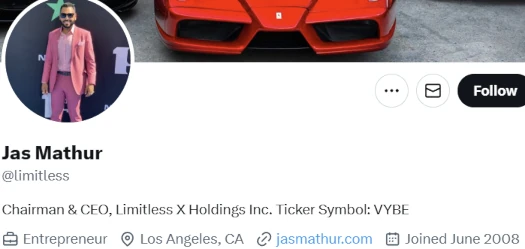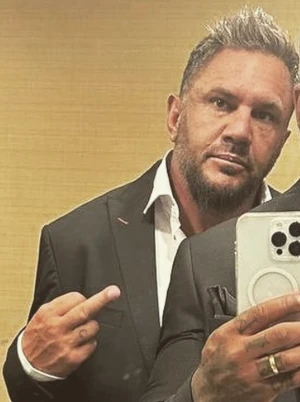Jas Mathur sues Travis Bott over Traders Domain Ponzi losses
![]() Jas Mathur has sued Travis Bott and Richard Jason Bott over reported Traders Domain Ponzi losses.
Jas Mathur has sued Travis Bott and Richard Jason Bott over reported Traders Domain Ponzi losses.
Mathur is a Canadian national from India living in California.

Travis Bott is behind a series of fraudulent MLM investment schemes targeting consumers around the world. These include Ryze AI, Westmyn, Onyx Lifestyle, Digital Profit, Meta Bounty Hunters and Meta Lab Agency
 Richard Jason Bott is believed to a relative of Travis Bott (right). Both Botts are Utah residents.
Richard Jason Bott is believed to a relative of Travis Bott (right). Both Botts are Utah residents.
As per a lawsuit filed by Mathur’s Wyoming shell company EM1 Capital LLC in California last October;
Since around mid-December 2022, T. Bott had been promoting a SIngapore-based investment fund to mutual friends of Jas Mathur, president of EM1.
Bott explained that the funds would be trading in Traders-Domain platform, which is controlled/managed by Fredirick “Ted” Safranko, a close friend and business partner of T. Bott for the past several years.
This is a bit of an odd timeline, seeing as Traders Domain collapsed in or around October 2022.
So far US regulators have only gone after part of Traders Domain, the SAEG Ponzi side of the business (~$145 million).
Safranko, a Canadian national has gone into hiding. In September 2023 the CFTC secured a $3.8 million judgment against Safranko.
Leaked financial records reveal the full extent of Safranko’s Traders Domain related fraud exceeds $370 million.
According to Mathur, Travis Bott had been recruiting people into DWHTD Technology PTE LTD (aka “Drive Fund”), a Singapore shell company.
Recruitment was done through Alliance Management Services LLP, a Utah shell company Travis Bott allegedly owns.
Following an introduction by a mutual friend, on January 5, 2023, T. Bott presented Mathur with an opportunity to invest $1 million in a “proprietary trading venture” whose returns, as established by historical performance, would generate an 18% monthly return on the investment over the course of one (1) year.
T. Bott elaborated to Mathur that he owned a company called SAVVY Wallet which was licensed by Evolve Bank & Trust, N.A.
According to T. Bott, all members and users of SAVVT Wallet would receive a debit card which would facilitate withdrawal of funds.
To that end T. Bott presented Mathur with a document entitled Investment Management Agreement, which Mathur signed on behalf of his company, Plaintiff EM1, on January 7, 2023.
 Savvy Wallet is owned by Frank DiCrisi (right) and Gregory “Tuffy” Baum. The payment processor was used to launder millions from The Traders Domain investors.
Savvy Wallet is owned by Frank DiCrisi (right) and Gregory “Tuffy” Baum. The payment processor was used to launder millions from The Traders Domain investors.
If Travis Bott had an ownership stake in Savvy Wallet, this is the first I’m hearing of it.
Pursuant to the terms of the IMA, EM1 agreed to invest $1 million in DWHTD and DWHTD agreed to pay a minimum of 18% every month on the total account balance of $1 million for thirteen (13) months.
FWHTD further agreed that at the end of the thirteen (13) month period, DWHTD would return 100% of EM1’s principal investment ($1 million).
The IMA further provides for termination upon non-performance of the agreement.
Specifically, non-performance is defined as monthly returns less than 18%.
Thus, in the event that DWHTD failed to make a monthly payment of 18% to EM1, EM1 had the right to terminate that agreement immediately and receive 100% of the principal funds back within thirty (30) days of termination.
DWHTD is represented by Lim Hang Guan Simon, a purported Singaporean citizen. A copy of the IMA between EM1 and DWHTD is attached to EM1’s Complaint as an exhibit:

After execution of the IMA, per T. Bott’s instructions, EM1 wired the principal investment of $1 million to AMS, a Utah company owned by T. Bott and R. Bott.
Per T. Bott, the 18% monthly interest payments from the $1 million investment would be disbursed monthly into Mathur’s SAVVY Wallet.
You can probably guess what happened next…
On February 3, 2023, Mathur contacted T. Bott, requesting that he be paid the return he was promised.
T. Bott replied that the funds only get disbursed after a full thirty (30) days, so a payment would be forthcoming in the middle of February 2023.
On February 16, 2023, T. Bott called Mathur and stated that the operators of the funds had an issue, this time attempting to distinguish his role at the fund as a mere investor, rather than an owner.
Despite his new claim that he was just an investor, T. Bott proceeded to advise Mathur that the account had taken around a 50% loss, and Mathur could either get back $650,000 today … or wait until the end of March and receive the past-due 18% returns from January, February and March.
T. Bott elaborated that other mutual friends who invested through him all opted to wait until the end of March.
Mathur would later realize Bott had convinced his mutual friends that it was he who had opted to wait till the end of March “and that they should follow his lead”.
On March 14, 2023, Mathur met with T. Bott in Los Angeles, California to discuss his investment.
Prior to the meeting, Mathur performed an internet search of the Trading Platform, only discover that Ted Safranko was charged by the CFTC in a $144,043,883 fraud.
Upon informing Bott of his findings, Bott is alleged to have grown “irate and began insulting Mathur”.
The conversation deteriorated when T. Bott threatened Mathur is front of two mutual friends, stating that he had a gun on him and would use it on Mathur.
As those present endeavored to de-escalate the situation, Mathur queried T. Bott as why, as such a purported big shot, he could not just wire Mathur the $1 million back immediately without any profits.
T. Bott responded that he would do it the following day but changed his mind minutes later, and instructed Mathur to wait until the end of this month, and if there was no progress, T. Bott said he would “vouch for it”.
Subsequently, T. Bott advised Mathur that, due to involvement of mutual friends between the two, T. Bott would provide a loan against the funds in the Meta Trader account until a supposed “withdrawal issue” could be navigated.
As at the time of filing his lawsuit, Mathur claims “no loan or other payments have been made”.
Rather, following involvement of counsel and a preliminary investigation, it has become evidence that the entire investment opportunity is and always was a sham.
In line with The Traders Domain having already collapsed by the time Bott made the DWHTD investment offer to Mathur, Mathur further learned
DWHTD was incorporated on December 28, 2022, which is after T. Bott floated the investment opportunity to Mathur’s acquaintances in mid-December 2023 with representations that the company historically could return the promised 18% monthly returns on investment.
[Furthermore] DWHTD has no actual physical presence in Singapore and its address is a corporate agent, offering incorporation services and a “virtual” address.
Mathur also noted DWHTD’s stated business nature was “trading of gold against the dollar” in the IMA. DWHTD’s shell company registration however stated it was involved in “development of software and applications (except games and cybersecurity)”.
Next, for a reason that remains unanswered, T. Bott directed Mathur to wire the funds to a Utah company T. Bott owns with his brother, R. Bott.
This company is not listed in the IMA and has no visible connection to anything subject to the IMA.
Mathur concludes;
In sum, this transaction is, on its face, a scam perpetrated in a blunt fashion, through plain fraud.
There are no returns, there is no live viable company, and there is no trading.
Rather, T. Bott and his brother R. Bott, simply defrauded EM1 out of $1 million.
Causes of action against DWHTD and the Botts include:
- fraud;
- conversion;
- violation of Penal Code section 496; and
- breach of contract
On or around February 7th, 2024, Bott had Mathur’s Complaint moved from the Los Angeles Superior Court to the Central District of California.
On March 27th, Bott filed his answer to Mathur’s complaint – mostly denying Mathur’s allegations. Bott also filed a counterclaim against Mathur, alleging “intentional infliction of emotional distress”.
As opposed to pitching Mathur himself on The Traders Domain, Bott claims “third parties” did his dirty work.
What exactly was represented represented to Mathur regarding the Drive Fund is unknow [sic].
However, after discussing the opportunity with the third parties, Mathur became immersed with the Drive Fund, and therefore wanted to invest $1,000,000, hoping that he would receive a large return on his investment.
Again, pursuant to The Traders Domain collapsing in or around October 2022, Bott claims
the Drive Fund was no longer accepting further investments.
So, the only way to obtain a holding in the Drive Fund would be to purchase all or part of an existing holding from someone who had already invested in the opportunity.
Once purchased, the already-invested holder would transfer part of his holding to the purchaser, thereby granting the purchaser a position in the Drive Fund in an amount equal to his purchase.
Bott claims undisclosed “third parties … each had a $1,000,000 in the Drive Fund” [sic].
Because Mathur wanted a $1,000,000 holding himself, he was unable to take the holding by the third parties since they did not have enough to transfer.
As a result, the third parties informed Mathur they had an acquittance [sic] who had several millions of dollars in the Drive Fund, and who may be willing to transfer a million dollars of that holding to Mathur. That acquittance [sic] was Bott.
Bott claims it was only then that he met Mathur.
Per Mathur’s request, the third parties reached out to Bott and inquired whether he would be willing to sell a million dollars of his holding in the Drive Fund to Mathur.
At first, Bott was reluctant to sell any portion of his holding to Mathur because he was not familiar with Mathur and had no prior relationship whatsoever.
However, because of Bott’s close relationship with the third parties, he eventually acquiesced to their request and agreed to meet with Mathur.
Thereafter, Mathur and Bott spoke on the phone. Bott was very clear to Mathur that he was not making any representations or guarantees regarding the Drive Fund, and that Mathur needed to conduct his own due diligence to determine whether he
wanted to proceed with the transaction.
Bott agrees the exhibited IMA was executed in early January 2023. Bott doesn’t explain why himself or his Utah shell company didn’t appear on any signed agreements.
On January 9, 2023, Mathur transferred $1,000,000 to Bott’s company.
That same day, Bott transferred $1,000,000 of the Drive Fund holding to Mathur’s company’s, EM1 Capital, LLC.
Again, remembering that The Traders Domain collapsed in or around October 2022, Bott alleges;
As time went one, the Drive Fund eventually defaulted, and the opportunity went nowhere. Fortunately for all the investors, the Drive Fund refunded everyone their initial investment plus any additional return that was gained while the Drive Fund was
active.The funds were transferred to each investor’s Trader Domain account.
However, at the same time the Drive Fund defaulted, Trader’s Domain began having liquidity issues, and all accounts were placed on hold.
To date, all Trader Domain accounts are placed on hold. As a result, no investor of the Drive Fund has been able to withdraw their funds from the Trader Domain platform. This includes both Bott and Mathur.
Bott’s allegations require shifting locking of investor accounts to around February or March 2023 – six months or so after The Trader Domain collapsed.
The rest of Bott’s counterclaim presents him as an innocent bystander;
Although Mathur made his decision to invest in the Drive Fund prior to meeting Bott, Mathur for some reason blamed Bott for having invested his $1,000,000.
Interestingly, the funds that were returned by the Drive Fund were sitting in a Trader Domain account that Mathur already had prior to speaking with Bott.
Bott had nothing to do with the activation of the Trader Domain account. Despite this, Mathur blamed Bott for his inability to withdraw the funds.
Subsequently, Mathur went on a rampage with threats against Bott.
For example, on or about March 12, 2023, Mathur was at a meeting at a private house with Bott and several other individuals.
During the meeting, Mathur approached Bott and began blaming him for not being able to withdraw the $1,000,000 mentioned above.
He then proceeded to make threats against Bott’s life unless the money was paid back.
After the threats were made, the third-party individuals present at the home got in between Mathur and Bott and broke up the confrontation.
In addition, Mathur has instructed certain individuals to contact Bott via text message to make death threats unless the $1,000,000 was paid back to Mathur.
Also, it has recently been discovered that Mathur was present at a party in California. Several attendees were friends of Bott.
During that party, Mathur began inquiring about Bott’s physical location, claiming that Mathur needed to get him served
with the complaint at issue.However, Bott had already been served with the complaint and Mathur was fully aware of this fact. Thus, it was clear that Mathur was attempting to find Bott to further carry out his death threats, and perhaps even to hurt Bott.
Bott asserts allegedly stealing $1 million from Mathur has left him “emotionally harmed”.
Bott is in fear for his life and continues to suffer emotional damage.
On April 12th, the court granted a motion by Richard Jason Bott to dismiss Mathur’s case against him. The dismissal was granted on personal jurisdiction grounds, not the merits of Mathur’s allegations.
Mathur was also denied from serving DWHTD Technology PTE LTD via email.
On April 10th, Mathur filed his First Amended Complaint. CTB Rise International Inc. was added as a defendant.
On May 23rd, Bott’s attorney informed the court that a private settlement had been reached. As a result, the court dismissed the case on May 24th.
From a regulatory and law enforcement perspective, the underlying alleged securities, commodities and wire fraud, as well as suspected money laundering, remains unaddressed.
Such is the case with the wider The Traders Domain Ponzi scheme, with total investor losses pegged at around $3.3 billion.


I’m sorry, but anybody who participates in one of these crypto or most financial based MLM’s deserves what they get when the hammer slams down on their heads.